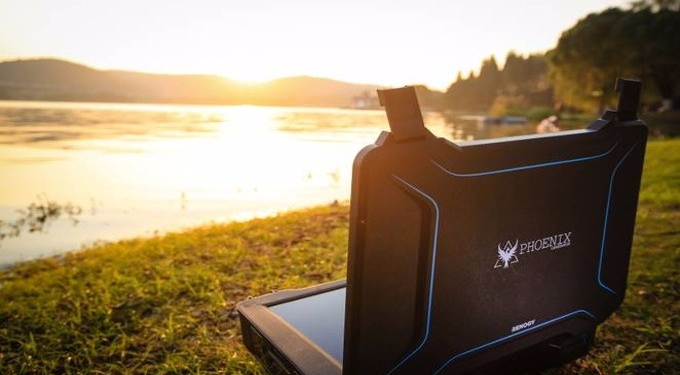
By Derek Markham | Treehugger
With 20 watts of solar panels, a 16Ah lithium-ion battery bank, and an onboard inverter, along with multiple charging ports, this compact solar generator is a great off-grid accessory.
Last month, I wrote about Renogy's solar briefcase product, the Phoenix, saying that it looked like a decent contender in the mid- to large-sized portable solar charger market, but like many things we cover on TreeHugger, it's hard to really know for sure about products without getting our hands on one and putting it to the test ourselves. As luck would have it, I recently got to spend a few weeks with a loaner unit of the Phoenix, and while it's not a perfect solar solution, it's certainly got a host of great features that could make it a great addition to your camping gear, emergency preparedness kit, or even just your tailgating or picnicking setup.
Before getting into the nuts and bolts of the Phoenix, here's a promo video that's long on style and short on details:
The Renogy Phoenix, which is about the size of a briefcase (16.24 x 11.95 x 3.94 inches) when closed, weighs just under 13 pounds and opens up to present a pair of 10W monocrystalline solar panels to the sun for charging. Two strong latches hold the unit closed when not being used for solar charging, and a large handle makes carrying it along rather easy, although its size and weight aren't necessarily conducive to backpacking trips. A single power switch on the top (handle-side) turns the Phoenix on, and separate buttons control whether AC or DC current will flow to the outlets on the side of the unit. A small display on the top relays information about the battery's charge level, as well as the strength of the sun on the solar panels (allowing for users to position it for optimal charging).

On the right side of the Phoenix, a set of charging ports is accessible behind a cover plate, with 4 USB ports (5V 2.4A), two 12V ports (3A), a 12V 12.5A cigarette socket, and a standard 3-prong 110V AC outlet (150W max continuous output). On the left side are the input ports, used for charging the Phoenix's internal 14.8V 16Ah lithium-ion battery bank, including an AC plug (for use with the included cord), a 12V input for charging from a car cigarette socket, and two ports for additional solar panel inputs. Also on the left side is a 3W LED light, which can be used at full power, dimmed for lower light needs, or in flashing mode for emergencies. The battery, which is replaceable at its end of life (said to have a lifecycle of about 1500 charging cycles), is under a plate on the bottom of the unit and is comprised of lithium-ion NMC (nickel-manganese-cobalt) cells.

The Phoenix is built in a sturdy ABS case, which appears to be rugged enough to take most normal bumps and jolts, and has a set of four rubber feet on the bottom for when laid flat. The unit isn't waterproof, but spring-loaded doors protect both the input and output port sections, which should keep out dust, dirt, and grime during transport, and the Phoenix has wide feet that keep it stable and upright when in the vertical ‘briefcase' position.

Charging the unit's battery with solar energy is said to take about 15 hours, which seemed about right to me, as I used the Phoenix battery to charge multiple gadgets until its charge was drawn down, and it took two partial days of sunlight to charge it to full again. One of the selling points on the unit is that additional solar panels can be hooked up to it (up to 100W additional, for a total of 120W), which would speed up charging considerably, with a full charge taking just a few hours.
The unit has a built-in pure sine wave inverter, so it should play nicely with most, if not all, small AC appliances. I was able to charge my laptop with it several times on a full charge and had no issues. However, it still surprises me that I need to plug in my laptop cord (which has an inverter in it to convert AC current to the DC that the laptop needs) to the AC outlet on the device, which essentially converts the battery's DC current to AC current. It seems silly to have to put up with the conversion losses of going from solar-generated DC current to the internal inverter to convert to AC, and then my laptop cord converts the AC back into DC for charging the laptop battery. Perhaps one day we'll see straight DC-to-DC solar charging options for laptops and larger electronics.















